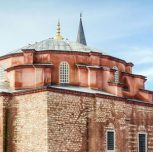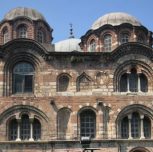The Valide Mosque stands at the very beginning of the Atatürk Boulevard, at the crossroads of the Aksaray Square. It was built on the order of Pertevniyal Sultan, the mother of Abdulaziz (1861-1876), and was constructed by the Sarkis Balyan in 1871. It is claimed by some sources that the architecture of the mosque was Montani, an Italian architect.
There had previously stood a mosque named Hacı Mustafa Ağa located on the former site of the Valide Mosque. The present-day Valide Mosque was built on the ruins of that mosque. It was mainly designed as a complex which including a muvakkithane (a time keeping Room), a fountain, a tomb and Sıbyan Mektebi (an Ottoman elementary-primary school). The mosque is composed of two sections: the last prayer section and the Harim (sanctum sanctorum). The size of the Harim is 10X10m, and the ceiling structure is composed of a dome.
Among the historical mosques of Istanbul, its ornaments and decorations have been more extensively used than others. The western impact on the architectural design during the period, combined with 16th-17th century decoration techniques, have been blended together in the mosque. Additionally, the decorations still shine with a gleaming, blue color, and its engraved ornaments have become prominent elements within the architectural aesthetic. Both the inner and outer sides of the mosque’s walls are marble panels decorated with motifs and calligraphies depicting selected verses from the Qur’an. The stone workmanship on the court door opening toward the Aksaray Square is the pinnacle of success of Ottoman stone workmanship.
The Valide Mosque was built in the late 19th century. The tomb of Pertevniyal Sultan, the muvakkithane (time keeping Room), and the fountain have been moved, during the Aksaray Square’s renovation, which began in 1956 and ended in 1959, the same year as the opening of the Vatan Street and of Millet Street. Afterwards, the fountain was moved to the mosque’s courtyard.
Due to the renovation of the underpass and of the upper roads as well as to the increasing of the overall height of the road, the mosque appears to be burried underground today. In this historical mosque, located in the crowded Aksaray district, renovation still continues today.










